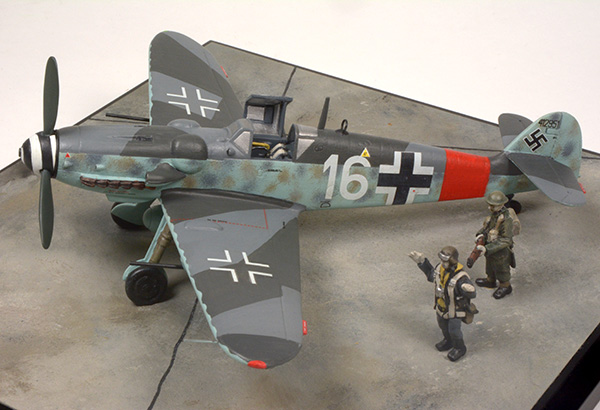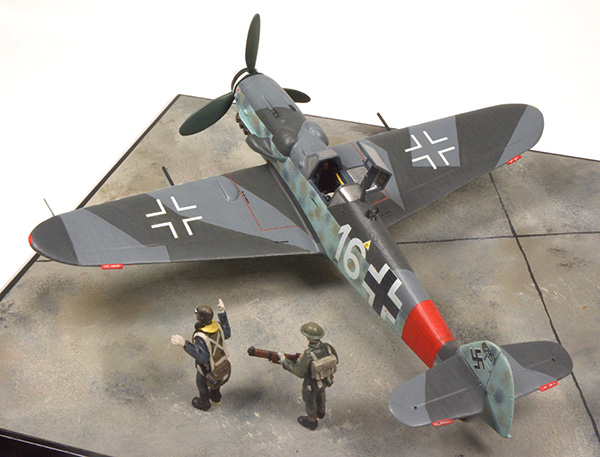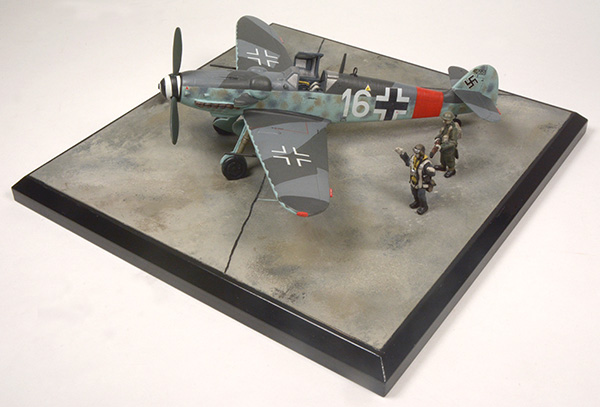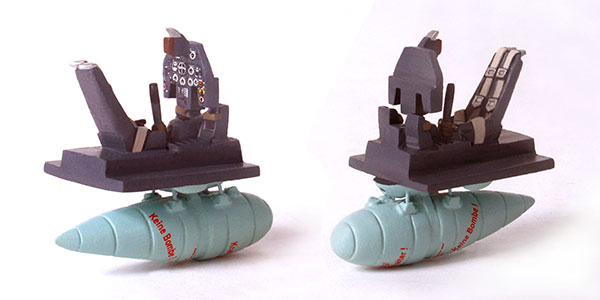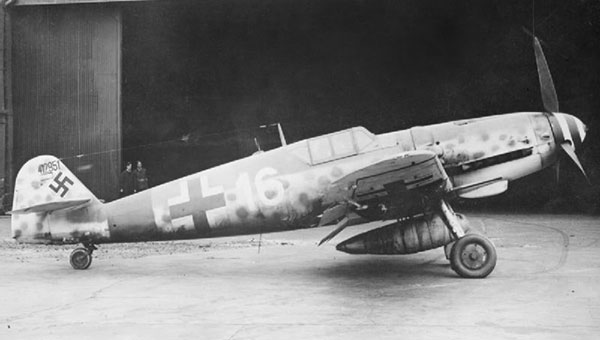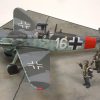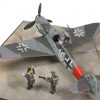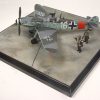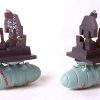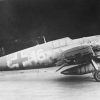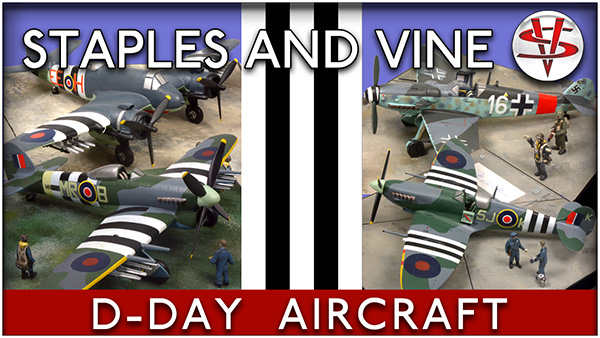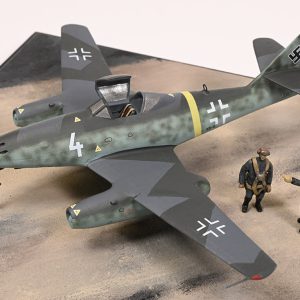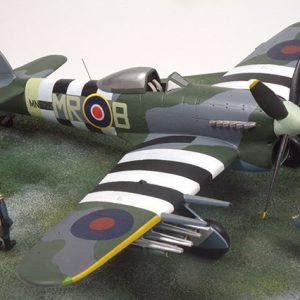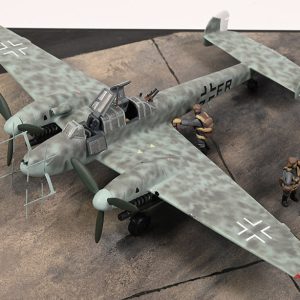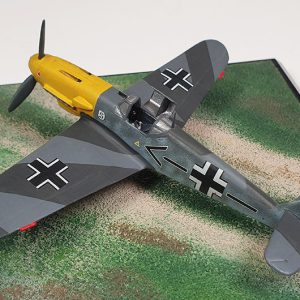“White 16” Wk Nr 412951 NS+FE 1./JG 301
Leutnant Horst Prenzel, Épinoy, France, July 1944.
FIND OUT MORE ABOUT THE Bf 109G-6/U2
ON MY YOUTUBE CHANNEL BELOW
The Messerschmitt Bf 109 was the subject of continuous development from its introduction to combat with the Condor Legion in the Spanish Civil War until the fall of the Third Reich in 1945. The G-series, or Gustav as it was widely but unofficially known, was considered by some experts to be the most efficient of the type. By mid-1944 age had begun to catch up with Willy Messerschmitt’s fighter and the Bf 109G was no longer able to engage contemporary allied fighters, such as the Spitfire Mk. IX and Mustang III, on equal terms. Nonetheless, the Gustav made a formidable antagonist for allied bombers with its heavy firepower, reasonable overtaking speed and small target profile. To counter increasing enemy night activity over Reich territories, Jagdgeschwader 301 (JG 301) was formed on 1st October 1943 in Neubiberg. In June 1944, I Gruppe JG 301 moved westwards to St. Dizier and later to Épinoy. As a single-seat night fighter unit, JG 301 engaged in “Wilde Sau” (wild boar) operations. The originator of this technique was Luftwaffe officer Major Hajo Herrmann. In the spring of 1943, Herrmann proposed an experimental evaluation in the use of free-ranging day fighters at night to counter the increasingly destructive RAF night attacks. Fighter planes were not directed using the tactical guidance of radar ground stations to the target, but rather interception was based, after radio guidance to the general area of the bomber stream, on the pilot’s vision and personal judgment. During the first twenty-four hours of Operation Overlord, the Allied air forces flew a total of 14,674 sorties for the loss of 113 aircraft, many by friendly fire. Such was the Allied air supremacy that the Luftwaffe only flew 319 sorties in the same period. July 1944 was another busy month for the defenders of the Reich and their opponents. On July 7th, RAF aircraft were called in to bomb enemy positions in the city of Caen after the Allied invasion had stalled; the first of five such attacks before mid-August. Interestingly, later in the month, a Mosquito of No. 544 Squadron was attacked by a German Me 262 fighter; the first ever documented jet fighter engagement. On 20th July, the Eighth Air Force dispatched 1,172 bombers and 542 fighters to hit oil and industrial targets in Germany; 19 U.S. bombers and 8 of their fighter escorts were lost. On the night of 20th/21st July, more than seven hundred British bombers attacked several strategic goals; the oil refineries in Bottrop and Homburg, the railway junction at Courtrai and some V1 flying bomb positions. In the early hours of 21st July, Leutnant Horst Prenzel (Staffelkapitan 1./JG 301) landed his Me 109G-6/U2 “White 16” at RAF Manston by mistake after an uneventful ‘Wilde Sau’ sortie over the Normandy invasion area. Prior to his capture, Leutnant Prenzel participated in twenty-five operational flights and scored two victories. The RAF evaluated the aircraft at the RAE Farnborough, and then passed it to the Air Fighting Development Unit at RAF Wittering in August 1944. “White 16” was written off in a takeoff accident at the airfield on 23rd November 1944. “White 16” was fitted with the Daimler-Benz DB 605A-1 12-cylinder inverted-vee engine of 1475 h.p. Like other G-6/U2 variants of Messerschmitt’s fighter, Prenzel’s aircraft incorporated a GM-1 system for injecting nitrous oxide into the engine. This increased the amount of oxygen in the fuel mixture, and thereby improved high-altitude performance. Armament comprised one engine-mounted 20 mm MG 151 cannon, fixed forward, and firing though an extended propeller shaft and a pair of 13 mm MG 131 machine guns in the nose. “White 16” carried 20 mm MG 151 cannon in underwing gondolas to create a formidable “Kanonenvogel” (“gunbird”). A distinguishing feature of “White 16” was the re-designed fin and rudder. The enlarged rudder utilized a mass-balance instead of the pervious horn-balance. To aid night operations, the aircraft was fitted with FuG 16Z and FuG 25A “identification friend or foe” (I.F.F.) equipment and the cockpit was provided with ultra-violet lighting. Increased endurance was facilitated by one 66-gallon N.K.F. drop-tank. “White 16” was fitted with a Zeiss Revi 16.B gunsight, equipment not been previously seen by the allies. The change from the Zeiss C.12/D sight was that the entire apparatus could now be swung down and sideways, to keep from impeding the pilot’s forward vision. It also lessened the chances of facial injuries during crash landings. The upper surfaces of “White 16” were finished in the standard splinter pattern of RLM 74 dark grey and RLM 75 middle grey so common to Luftwaffe fighters after 1941. Undersides were painted in RML 76 light blue. The aircraft’s fuselage was mottled in RLM 02 grey and RLM 75 middle grey. The aircraft sported the red band aft of the fuselage indicative of early “Wilde Sau” units. Some sources have identified this aircraft with 1./JG 1. However as of the 21st of July 1944 1./JG 1 only flew the Focke Wulf Fw 190A-8. The red tail band was used from mid 1944 to early 1945 by three fighter groups: JG 1, JG 300, and JG 301. During February 1945 instructions were issued which allowed only JG 1 to utilize the the red band while JG 300 used blue-white-blue and JG 301 used yellow-red.


